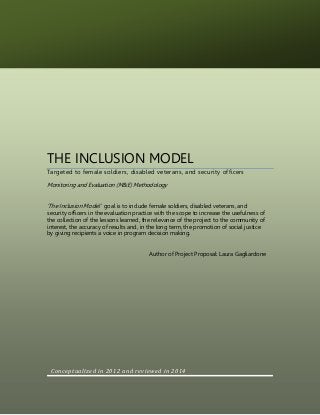THE INCLUSION MODEL targeted to female soldiers and disabled veterans - Laura Gagliardone
•
1 like•375 views
Report
Share
Report
Share
Download to read offline

Recommended
Recommended
More Related Content
Featured
Featured (20)
Product Design Trends in 2024 | Teenage Engineerings

Product Design Trends in 2024 | Teenage Engineerings
How Race, Age and Gender Shape Attitudes Towards Mental Health

How Race, Age and Gender Shape Attitudes Towards Mental Health
AI Trends in Creative Operations 2024 by Artwork Flow.pdf

AI Trends in Creative Operations 2024 by Artwork Flow.pdf
Content Methodology: A Best Practices Report (Webinar)

Content Methodology: A Best Practices Report (Webinar)
How to Prepare For a Successful Job Search for 2024

How to Prepare For a Successful Job Search for 2024
Social Media Marketing Trends 2024 // The Global Indie Insights

Social Media Marketing Trends 2024 // The Global Indie Insights
Trends In Paid Search: Navigating The Digital Landscape In 2024

Trends In Paid Search: Navigating The Digital Landscape In 2024
5 Public speaking tips from TED - Visualized summary

5 Public speaking tips from TED - Visualized summary
Google's Just Not That Into You: Understanding Core Updates & Search Intent

Google's Just Not That Into You: Understanding Core Updates & Search Intent
The six step guide to practical project management

The six step guide to practical project management
Beginners Guide to TikTok for Search - Rachel Pearson - We are Tilt __ Bright...

Beginners Guide to TikTok for Search - Rachel Pearson - We are Tilt __ Bright...
Unlocking the Power of ChatGPT and AI in Testing - A Real-World Look, present...

Unlocking the Power of ChatGPT and AI in Testing - A Real-World Look, present...
THE INCLUSION MODEL targeted to female soldiers and disabled veterans - Laura Gagliardone
- 1. THE INCLUSION MODEL Targeted to female soldiers, disabled veterans, and security officers Monitoring and Evaluation (M&E) Methodology ‘The Inclusion Model ‘ goal is to include female soldiers, disabled veterans, and security officers in the evaluation practice with the scope to increase the usefulness of the collection of the lessons learned, the relevance of the project to the community of interest, the accuracy of results and, in the long term, the promotion of social justice by giving recipients a voice in program decision making. Author of Project Proposal: Laura Gagliardone Conceptualized in 2012 and reviewed in 2014
- 2. THE INCLUSION MODEL TARGETED TO FEMALE SOLDIERS, DISABLED VETERANS, AND SECURITY OFFICERS Monitoring and Evaluation (M&E) Methodology Author of the Project Proposal: Laura Gagliardone The experience I have acquired in research and monitoring and evaluation (M&E) of international programs and my knowledge about cross-cutting issues have allowed me to conceptualize a simple project, entitled ‘The Inclusion Model’. It has to be structured with the team members and then utilized to conduct applied research, analysis, and evaluation of the soldiers and security officers’ experiences in the field. Women, disabled veterans, and security officers have to be given special focus in order to prevent isolation and suicide. ‘The Inclusion Model’ goal is to include female soldiers, disabled veterans, and security officers in the evaluation process in order to increase the accuracy of the information collected and the lessons learned, the relevance of the project to the community of interest and, as ultimate scope, the promotion of social justice by giving recipients a voice in decision making. A disability is a physical or mental impairment that substantially limits one or more major life activities. Unfortunately, soldiers and security officers who serve the United States in the field can experience abuses and violence and that affects their psychological wellbeing until they are no more able to have a normal life when they get back home. Therefore putting some of them in control of research is necessary to shift the perspective from the simple medical model to the social model whereby disability becomes a problem in sociality and in establishing relationships. Obviously, there are several challenges that need to be faced, for example people with disabilities may not even recognize their own problem or may encounter a wide range of cognitive abilities or preferences for how to communicate. They could prefer writing instead of speaking and sometime words and concepts could be misleading or confusing to the researchers and evaluators. Therefore it is important that researches are aware that obtaining a response from an interviewee does not necessarily mean that she or he understands exactly what has been asked, especially if the participants are not familiar with the evaluation techniques. In addition, some people with certain psychiatric disorders, such as bipolar or schizophrenia, demonstrate impairments in verbal and nonverbal communication as part of their condition (to be continued). ‘The Inclusion Model’ also takes into account the feasibility of inclusion: adequate tools, resources, evaluators’ training, participants’ characteristics, and program context. If perceived benefits are high, evaluators may be convinced that inclusion is worth investing in, even if it is perceived to be costly (to be continued). Evaluators may encounter certain challenges to collect data in some contexts, and they have various strategies to draw on when this occurs (to be continued). Finally, the validity of data collection methods should be studied further to ensure that recipient voices, when included, are accurately represented, especially in evaluations where this is the only way recipients are involved in. Evaluators should ensure that inclusion is designed strategically to achieve the desired goal of participation, and should focus energy and resources accordingly (to be continued).